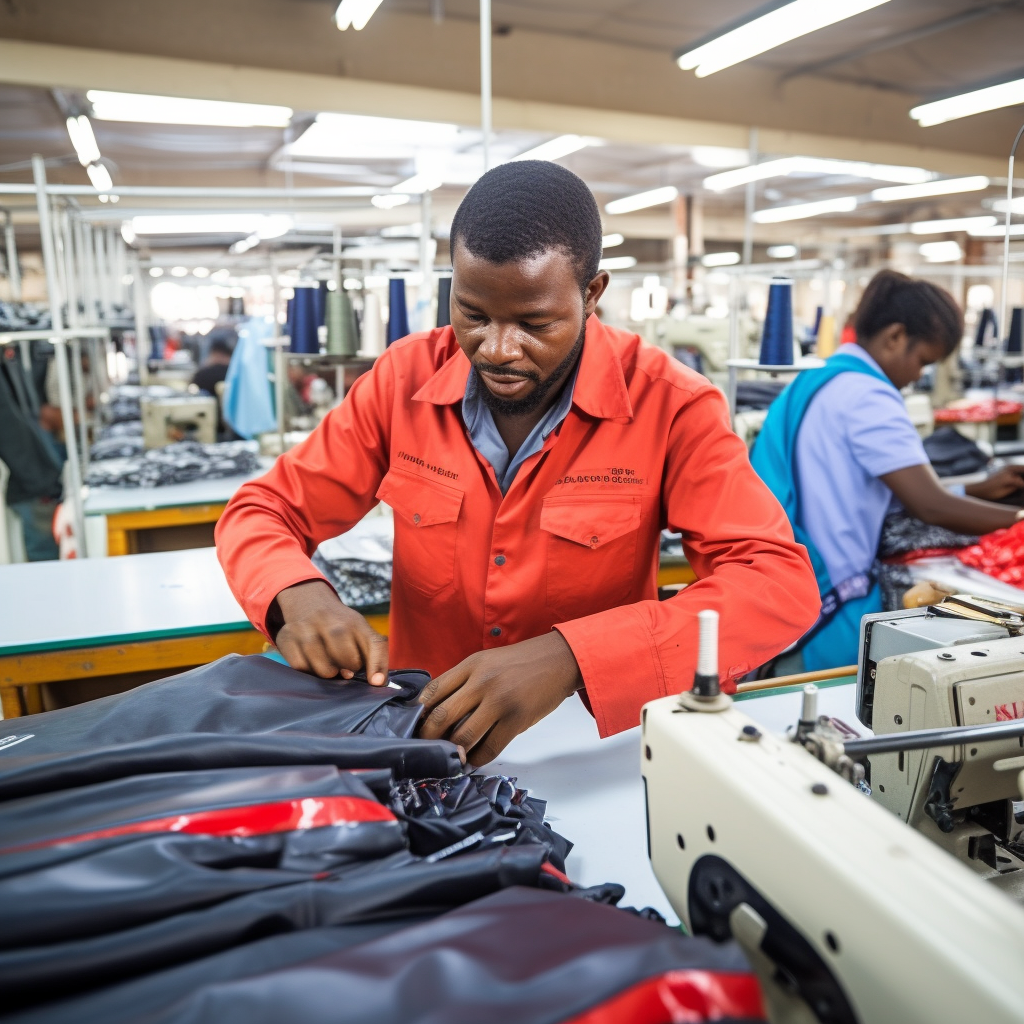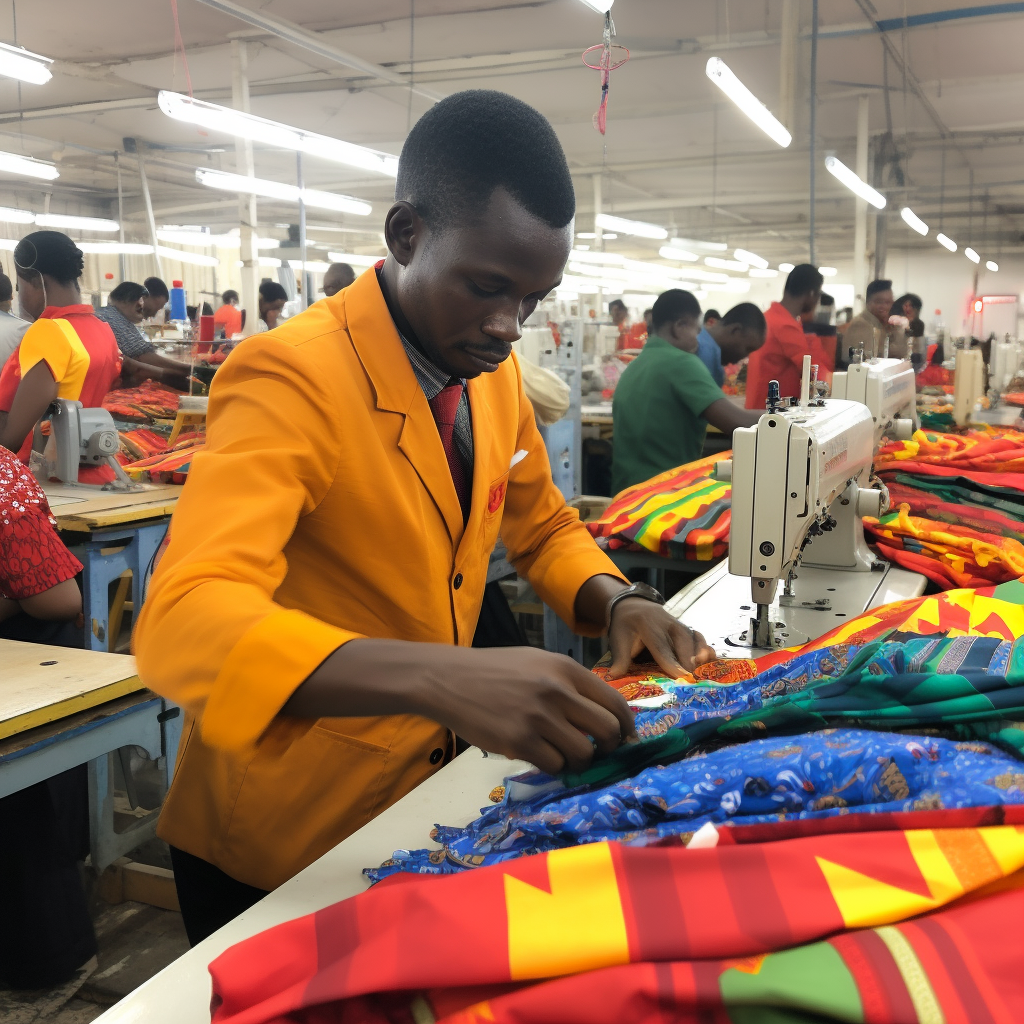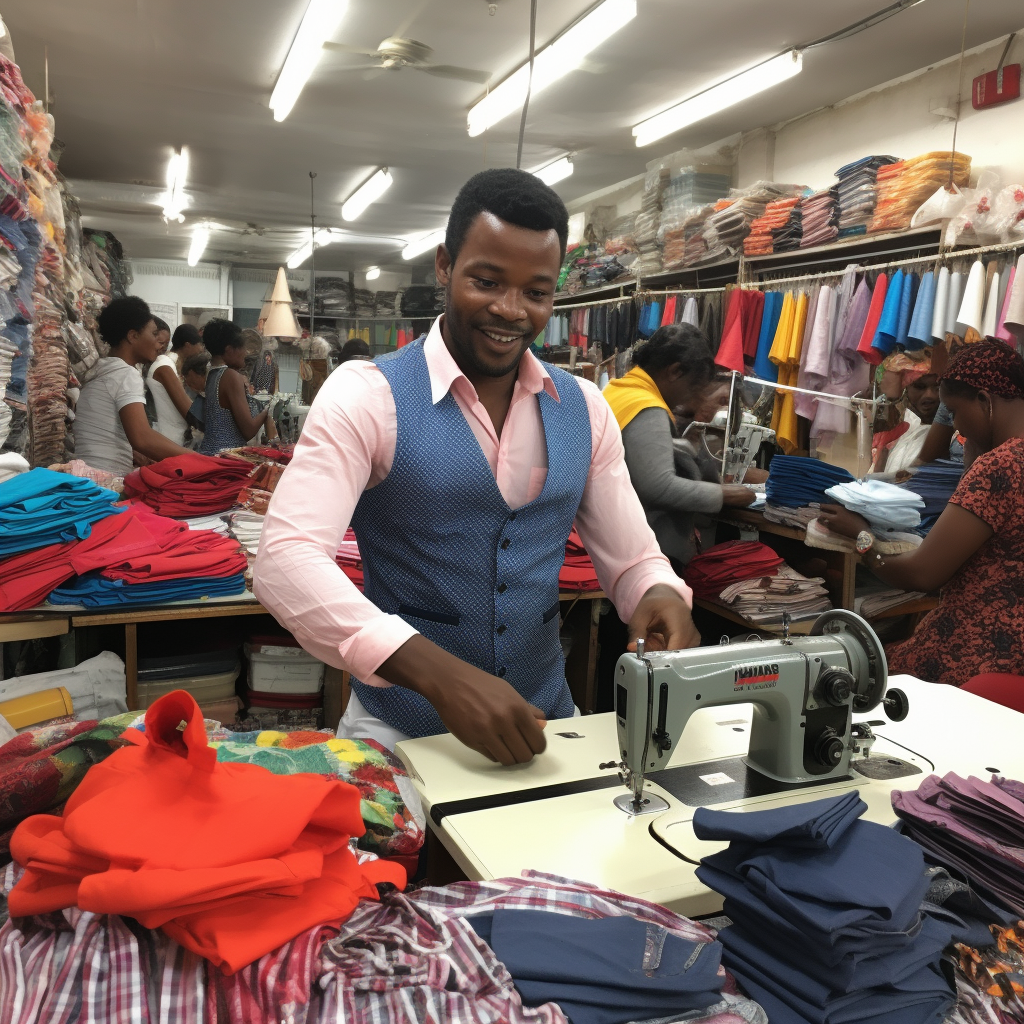Fashion in Zambia is a vibrant and ever-evolving tapestry of culture, innovation, and entrepreneurial prowess. A rising number of talented designers and skilled artisans are putting Zambian fashion on the global map. At the heart of this growth lies the thriving clothing manufacturing industry that has steadily gained traction, not only for its unique and captivating designs but also for its significant socio-economic impact.
In this in-depth article, we will delve into the world of Zambia’s top six clothing manufacturers – Kutowa Designs, Mangishi Doll, Chizo Designs, MaFashio, African Butterfly, and Barefeet Theatrewear. We will explore their origins, design ethos, and the quality of their products. Furthermore, we will assess their impact on Zambia’s economy and discuss the challenges and opportunities they face in today’s dynamic and competitive market.
With comprehensive coverage of each subject area, this article will provide an evergreen resource for anyone interested in Zambia’s clothing manufacturing sector.

History of Clothing Manufacturing in Zambia
Clothing manufacturing in Zambia, like many African countries, has a rich history tied closely to its cultural heritage. The traditional attire was largely made from locally available materials, such as animal skins and tree barks. However, the advent of trade and colonization brought significant changes, introducing fabrics such as cotton and silk.
Table 2.1: Timeline of Zambia’s Clothing Industry Evolution
| Period | Significant Events |
|---|---|
| Pre-Colonial Era | Use of animal skins and tree barks for clothing. |
| Colonial Era (19th – mid 20th century) | Introduction of cotton and silk through trade routes. Small-scale local tailoring emerges. |
| Post-Independence (1964 onwards) | Establishment of textile mills and clothing factories. Government initiatives to support local manufacturing. |
| Modern Era (21st century) | Emergence of designer labels and fashion houses. Recognition on international platforms. |
In the post-independence era, the Zambian government established textile mills and clothing factories to boost local production. The drive towards industrialization in the late 20th century saw the growth of clothing manufacturing industries, providing employment and contributing to the economy.
The modern era has seen an upsurge in designer labels and fashion houses, with several Zambian clothing manufacturers gaining recognition on international platforms. The evolution of the clothing industry in Zambia provides a backdrop for understanding the growth and status of the top manufacturers that we will be discussing in subsequent sections.

Analysis of the Zambian Clothing Market
Zambia’s clothing market is experiencing significant growth, driven by factors such as rising disposable income, a burgeoning middle class, urbanization, and the growing interest in African-inspired designs globally. The market is characterized by a mix of traditional attire, Western-inspired designs, and a blend of both, popularly known as Afro-fusion.
Table 3.1: Key Factors Driving Zambia’s Clothing Market
| Factor | Explanation |
|---|---|
| Rising Disposable Income | Increased earnings are allowing more people to invest in quality clothing. |
| Middle Class Expansion | The burgeoning middle class has a higher demand for fashionable clothes. |
| Urbanization | Urban dwellers are more exposed to global fashion trends and have a higher demand for contemporary designs. |
| Global Interest | There is growing international interest in African-inspired designs. |
Zambia’s clothing market is a combination of mass-produced and bespoke clothing. The mass-produced segment caters to the needs of consumers looking for affordable yet fashionable clothing. On the other hand, the bespoke segment serves those who prefer custom-made designs that reflect their individual style.
Several retail outlets, both physical stores and online platforms, provide consumers with a wide variety of choices. From modern shopping malls in urban areas to open-air markets in rural settings, the clothing industry in Zambia caters to a diverse consumer base.
Top 6 Clothing Manufacturers in Zambia
Let’s explore the top six clothing manufacturers in Zambia. These manufacturers have not only made a significant impact on the local fashion scene but have also managed to gain international recognition. They represent a mix of well-established and emerging fashion houses.
4.1 Kutowa Designs
Kutowa Designs is a fashion brand that embodies the vibrant Zambian culture in its designs. Founded by Towani Clarke in 2009, Kutowa Designs has gained international recognition and has showcased at fashion events across Africa and Europe.
Table 4.1: Overview of Kutowa Designs
| Aspect | Description |
|---|---|
| Founded | 2009 |
| Founder | Towani Clarke |
| Style | Afro-centric designs with a modern twist |
| Recognition | Showcased at fashion events in Africa and Europe |
4.2 Mangishi Doll
Mangishi Doll, founded by Kapasa Musonda, has gained a global following with its bold prints and Afrocentric designs. Musonda has been recognized by Forbes Africa in their “30 Under 30” list.
Table 4.2: Overview of Mangishi Doll
| Aspect | Description |
|---|---|
| Founded | 2012 |
| Founder | Kapasa Musonda |
| Style | Bold prints, Afrocentric designs |
| Recognition | Founder featured in Forbes Africa “30 Under 30” |
4.3 Chizo Designs
Chizo Designs, a fashion house led by Chisoma Lombe, stands out for its high-end African print clothing. The brand has made a mark with its modern interpretations of traditional Zambian attire and continues to inspire trends within and beyond the country.
Table 4.3: Overview of Chizo Designs
| Aspect | Description |
|---|---|
| Founded | 2013 |
| Founder | Chisoma Lombe |
| Style | High-end African print clothing |
| Recognition | Prominent brand within Zambia, with growing international attention |
4.4 MaFashio
MaFashio, started by the stylish Kunda sisters, is more than just a clothing brand. It is a lifestyle platform that includes a fashion blog, styling services, and a line of vibrant, contemporary clothing. The brand’s influence extends beyond clothing, contributing significantly to Zambia’s fashion narrative.
Table 4.4: Overview of MaFashio
| Aspect | Description |
|---|---|
| Founded | 2012 |
| Founders | Sekayi and Tukiya Kunda |
| Style | Vibrant, contemporary clothing |
| Recognition | Notable fashion influence within Zambia, with a strong digital presence |
4.5 African Butterfly
African Butterfly, founded by Nkandu Yatu, is known for its elegant, handcrafted designs that fuse traditional Zambian elements with modern aesthetics. The brand represents a distinct segment of Zambia’s fashion industry that values intricate craftsmanship.
Table 4.5: Overview of African Butterfly
| Aspect | Description |
|---|---|
| Founded | 2011 |
| Founder | Nkandu Yatu |
| Style | Handcrafted designs, traditional Zambian elements |
| Recognition | Highly regarded for its craftsmanship within Zambia, and beyond |
4.6 Barefeet Theatrewear
Barefeet Theatrewear is a unique brand in the Zambian fashion landscape. It produces costumes and attire for theatrical performances and is renowned for its innovative and expressive designs that often carry strong social messages.
Table 4.6: Overview of Barefeet Theatrewear
| Aspect | Description |
|---|---|
| Founded | 2006 |
| Founders | Adam McGuigan and others |
| Style | Costumes and attire for theatre |
| Recognition | Known for its socially conscious designs within Zambia and internationally |

Evaluating the Quality of Zambian Clothing Manufacturers
In this chapter, we will assess the quality of products from these top six Zambian clothing manufacturers. Factors considered include design originality, build quality, material selection, and customer satisfaction.
5.1 Design Originality
The uniqueness of designs is an essential factor in fashion. Zambian manufacturers excel in this aspect, providing original designs that seamlessly fuse traditional African aesthetics with modern fashion trends. Each of the manufacturers exhibits a unique style that differentiates them from the rest, enhancing their competitiveness and market appeal.
Table 5.1: Design Originality of Zambian Manufacturers
| Manufacturer | Originality Aspect |
|---|---|
| Kutowa Designs | Afro-centric designs with a modern twist |
| Mangishi Doll | Bold prints, Afrocentric designs |
| Chizo Designs | High-end African print clothing |
| MaFashio | Vibrant, contemporary clothing |
| African Butterfly | Handcrafted designs, traditional Zambian elements |
| Barefeet Theatrewear | Innovative and expressive theatrical costumes |
5.2 Build Quality
Build quality encompasses the integrity and durability of the finished products. High-quality stitching, strong seams, and the ability to withstand multiple washes are indicators of excellent build quality. Reviews from customers indicate that products from these manufacturers score high on these aspects, indicating a commendable level of workmanship.
Table 5.2: Build Quality Indicators
| Indicator | Description |
|---|---|
| Stitching | Quality of sewing, no loose threads or uneven lines |
| Seams | Strength and alignment of seams |
| Durability | Ability to maintain quality after multiple washes |
5.3 Material Selection
The choice of material significantly affects the comfort, durability, and overall look of clothing items. Zambian manufacturers often opt for high-quality African fabrics, such as Chitenge and Mukuba, which are vibrant, durable, and culturally significant. However, they also incorporate other materials like cotton, silk, and synthetic fabrics depending on the design requirements.
Table 5.3: Material Selection of Zambian Manufacturers
| Manufacturer | Materials Used |
|---|---|
| Kutowa Designs | African fabrics, cotton |
| Mangishi Doll | African prints, cotton blends |
| Chizo Designs | African prints, silk |
| MaFashio | Various fabrics for different styles |
| African Butterfly | Traditional Zambian fabrics, cotton |
| Barefeet Theatrewear | A range of materials based on costume requirements |
5.4 Customer Satisfaction
Customer satisfaction is a key indicator of a brand’s success and product quality. All these manufacturers have established a strong local and international customer base. They have positive customer reviews and testimonials, which speak to their product quality, customer service, and overall shopping experience.
Table 5.4: Customer Satisfaction Indicators
| Indicator | Description |
|---|---|
| Reviews | Positive reviews from customers |
| Repeat Customers | High rate of repeat customers |
| Customer Service | Responsiveness and helpfulness of customer service |
In summary, these six manufacturers adhere to high-quality standards in their design and production processes. They offer unique designs, use quality materials, ensure excellent build quality, and prioritize customer satisfaction.
Impact of Clothing Manufacturers on Zambia’s Economy
Zambia’s clothing manufacturers contribute significantly to the nation’s economy, directly and indirectly. They generate employment, support local textile industries, promote cultural heritage, and contribute to the nation’s GDP.
6.1 Employment Generation
The clothing manufacturing sector provides jobs for a large number of Zambians. From designers and tailors to sales personnel and logistics operators, the industry employs a diverse range of professionals. This employment generation contributes to poverty reduction and economic stability.
Table 6.1: Employment Generation
| Role | Job Description |
|---|---|
| Designers | Create new clothing designs |
| Tailors | Manufacture the clothing items |
| Sales Personnel | Manage the sale of clothes |
| Logistics Operators | Handle the delivery and distribution of clothes |
6.2 Support to Local Textile Industry
Zambian clothing manufacturers predominantly use locally sourced materials, thereby supporting the domestic textile industry. This creates a demand for local fabrics and encourages the growth of local textile businesses.
Table 6.2: Support to Local Textile Industry
| Action | Impact |
|---|---|
| Use of Local Fabrics | Creates a demand for local textiles |
| Sourcing Locally | Supports local textile businesses |
6.3 Cultural Promotion
Through their use of traditional fabrics and designs, Zambian clothing manufacturers play a crucial role in promoting and preserving Zambian culture. They help to bring traditional Zambian aesthetics to a global audience, enhancing the nation’s cultural profile.
Table 6.3: Cultural Promotion
| Action | Impact |
|---|---|
| Use of Traditional Designs | Preserves and promotes Zambian culture |
| International Exposure | Showcases Zambian aesthetics to a global audience |
6.4 GDP Contribution
The clothing industry contributes significantly to Zambia’s Gross Domestic Product (GDP). Through sales, exports, and taxes, it contributes to national revenue and drives economic growth.
Table 6.4: GDP Contribution
| Contribution | Description |
|---|---|
| Sales Revenue | Money generated from the sale of clothes |
| Exports | Revenue from the international sale of clothes |
| Taxes | Revenue generated from taxation of businesses |
Challenges and Opportunities in the Zambian Clothing Manufacturing Sector
While the Zambian clothing manufacturing industry shows promise and has made remarkable strides, it faces several challenges. However, these challenges also present opportunities for growth and innovation.
7.1 Challenges
Zambian clothing manufacturers face hurdles such as limited access to funding, high production costs, and intense competition from cheap imported clothes. They also grapple with skill shortages and the need for more advanced machinery.
Table 7.1: Challenges in Zambian Clothing Manufacturing
| Challenge | Description |
|---|---|
| Limited Funding | Difficulty in accessing loans or grants for business expansion |
| High Production Costs | High cost of materials, labor, and utilities |
| Competition | Intense competition from cheap imports |
| Skill Shortages | Lack of adequately skilled labor |
| Need for Advanced Machinery | Requirement for more efficient and technologically advanced machinery |
7.2 Opportunities
Despite these challenges, there are numerous opportunities for growth and development. Increased governmental support, expansion into e-commerce, and development of sustainable, eco-friendly practices can provide significant benefits.
Table 7.2: Opportunities in Zambian Clothing Manufacturing
| Opportunity | Description |
|---|---|
| Governmental Support | Potential for more government initiatives to support local businesses |
| E-Commerce | Opportunity to reach a larger customer base through online sales |
| Sustainable Practices | Potential for development of eco-friendly and ethical practices |
The Zambian clothing manufacturing industry, with its unique fusion of traditional aesthetics and modern trends, holds significant potential. The challenges it faces can become catalysts for innovation, driving the industry towards a more sustainable and prosperous future.
You may also like
-
What to Expect from Professional Emergency Towing Services in Adelaide
-
Crucial Role of TMT Bars in Earthquake-Resistant Building Designs
-
The True Cost of Registering a Company in the UK
-
Navigating the Global Valve Market in an Era of Innovation
-
Effective Maintenance Strategies for Industrial Electrical Equipment

